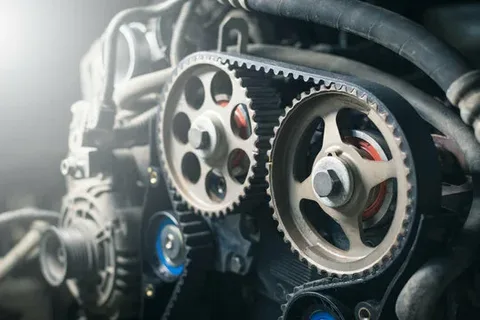Regular inspection of your SKF timing belt is essential for both automotive and industrial applications. As a precision-engineered component, a timing belt synchronizes camshaft and crankshaft movement, directly impacting engine performance and longevity. Early detection of wear or malfunction can save thousands in emergency repairs. This blog covers 5 warning signs requiring immediate attention, explains SKF timing belt kit components, and offers cost-effective maintenance strategies for professionals and enthusiasts alike.
Understanding SKF Timing Belt Technology and Precision Engineering
SKF timing belts are manufactured using advanced materials and ISO-certified processes to ensure stability, wear resistance, and quiet operation.
- Engineered with aramid fibers for high tensile strength
- Rubber backing and tooth facing optimize friction and minimize slippage
- Automatic tensioner units maintain constant belt tension under varying temperatures
- Idler pulleys are crafted for precise belt guidance and reduced lateral movement
- Backed by SKF’s global quality assurance and testing standards
The Critical Role of Timing Belts in Engine Synchronization
Timing belts ensure valves open and close at exact moments, preventing piston-valve interference in interference-engine designs. Proper belt function:
- Maintains precise camshaft/crankshaft alignment
- Reduces engine vibration and noise
- Optimizes fuel efficiency and emissions control
- Protects against costly internal damage from mistimed valves
- Supports auxiliary components like water pumps and injection pumps
Five Warning Signs Requiring Immediate Maintenance Attention
1. Excessive Belt Noise
- Squealing or chirping during startup or idle
- Indicates misalignment or tensioner wear
- Continuous noise can lead to tooth degradation
- Correction: Realign pulleys, replace tensioner
- Preventive: Inspect noise sources bi-monthly
2. Visible Cracks or Fraying
- Inspect belt teeth and backing for splits or fiber exposure
- Cracks often appear near idler or tensioner contact points
- Left unaddressed, belt failure is imminent
- Solution: replace belt and inspect pulleys for wear
- Best practice: photograph belt condition for records
3. Oil or Coolant Contamination
- Fluid glazing softens rubber, reducing tooth engagement
- Appears as shiny, slick belt surfaces
- Immediate flush and replacement required
- Check for seals or hose leaks causing contamination
- Incorporate solvent cleaning in inspection protocol
4. Excessive Belt Stretch
- Measured by comparing belt marks after installation
- Stretch beyond manufacturer spec signals fatigue
- Tensioner may fail to maintain proper tension
- Replace belt and automatic tensioner as a kit
- Use torque-wrench for accurate tension adjustments
5. Tensioner or Idler Pulley Failure
- Listen for grinding or clicking from tensioner bearings
- Wobble indicates bearing deterioration
- Damaged tensioners lead to uneven belt wear
- Replace both belt and pulleys as part of a timing belt kit cost-effective solution
- Regularly lubricate bearing housings where applicable
Comprehensive Timing Belt Kit Components and Their Functions
An SKF timing belt kit includes all parts needed for a full system overhaul:
- Main timing belt with aramid tensile cords
- Automatic or manual tensioner unit
- Idler pulleys for optimal belt routing
- Water pump (in WP suffix kits) for cooling system integration
- Seals and gaskets for contamination prevention
Step-by-Step Installation Procedures with Proper Tools
- Secure engine at top dead center (TDC) using locking pins
- Remove old belt, tensioner, and idler pulleys
- Clean mounting surfaces and check sprocket condition
- Install new belt, aligning timing marks precisely
- Fit tensioner and rotate to apply correct preload
- Manually rotate engine two revolutions to verify timing
- Reinstall covers, adjust auxiliary belt tensions
- Conduct a test run and recheck tension
Maintenance Schedules and Inspection Protocols
- Inspect every 20,000 km or 12 months, whichever comes first
- Replace at 100,000 km or per OEM recommendation
- Check tensioner and idler pulleys at each oil change
- Perform leak inspection for oil/coolant contamination
- Keep detailed service logs with condition photos
Performance Benefits of SKF Timing Belt Kits Over Standard Alternatives
SKF’s precision engineering delivers:
- Extended service life under high load conditions
- Superior heat and oil resistance for harsh environments
- Quieter operation with reduced vibration
- Integrated water pump options for system efficiency
- Global availability and OEM compatibility
Integration with Water Pump Replacement for Complete System Overhaul
Co-replacing the water pump with the timing belt:
- Prevents repeat labor costs if pump fails later
- Ensures coolant system integrity
- Water pump in SKF WP kits meets OE performance specs
- Simplifies warranty claims and service records
- Improves long-term system reliability
Conclusion
Proactive inspection and timely replacement of your SKF timing belt and associated components not only protect critical engine synchronization but also significantly reduce long-term maintenance costs and downtime. Recognize the five warning signs—noise, cracking, contamination, stretching, and pulley failure—to ensure immediate action. For a complete, reliable solution and expert support, Visit Bearing World for genuine SKF timing belt kits, professional advice, and seamless service.


